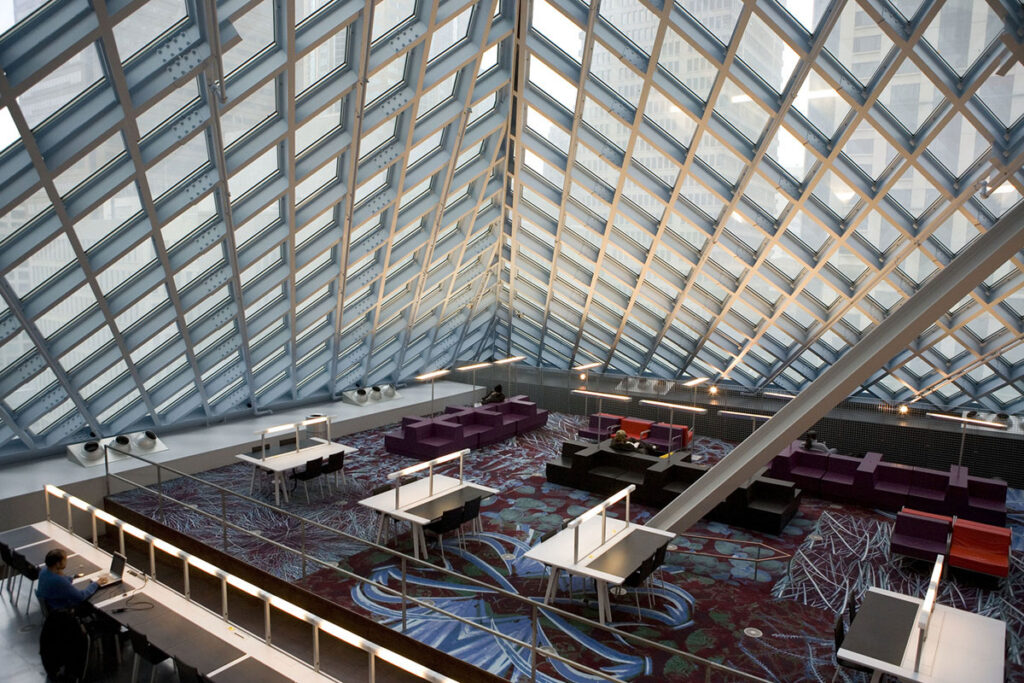
The Seattle Central Library is an iconic and innovative architectural landmark located in the heart of Seattle, USA. Designed by renowned architect Rem Koolhaas and the architectural firm OMA, the library is known for its unique, cutting-edge design and advanced use of technology. Officially opened in 2004, the library has become a symbol of modern architecture, urban renewal, and community-focused design. It is not just a library but also an architectural statement, merging functionality with aesthetic beauty.
1. General Information
- Name: Seattle Central Library
- Location: Seattle, Washington, USA
- Architect: Rem Koolhaas (OMA)
- Opening Year: 2004
- Architectural Style: Deconstructivism, Modernism
- Purpose: Public library
- Size: 362,987 square feet (33,000 square meters)
- Floors: 11 floors
- Sustainability: LEED Gold certified
2. Historical Background
The idea for the Seattle Central Library dates back to the early 1990s, when the city began exploring the possibility of constructing a modern, technologically advanced library for the community. The project gained momentum after Seattle residents voted for a bond measure in 1998 to fund the design and construction of the new library.
The city hired Rem Koolhaas and his firm OMA (Office for Metropolitan Architecture) after an international design competition. Koolhaas, known for his innovative and unconventional designs, proposed a revolutionary approach to the traditional concept of a library, focusing on open spaces, flexible layouts, and integrating new technologies into the design.
The library was completed in 2004, and it quickly became one of the most talked-about architectural projects in the world, praised for its bold design and forward-thinking vision.
3. Architectural Features
A. Innovative Design
The Seattle Central Library’s design is based on the concept of open spaces and flexibility. The structure is an intricate blend of geometric shapes, sharp angles, and transparent glass surfaces that create a dramatic visual effect. The library’s distinctive form resembles a series of stacked and rotated volumes, with sharp diagonals and overlapping structures, making it look like a futuristic and abstract sculpture.
The exterior of the library is primarily constructed with glass and steel, which allows natural light to flood the interior spaces, creating a bright and open atmosphere. The glass façade also gives the building an ethereal quality, especially when illuminated at night.
B. Functional Spaces
The library is designed with the community in mind, featuring an array of open reading areas, study spaces, and technology-driven environments. Key design elements include:
The “Books Spiral”: A continuous spiral ramp that holds the library’s entire collection of books, creating a unique, uninterrupted flow from the ground floor to the top. This innovative design eliminates the need for traditional shelving and makes it easier for patrons to browse the library’s collection.
The Auditorium: A multi-purpose space designed for events, lectures, and community gatherings. It features modern technology and a flexible layout that allows for different configurations based on the needs of the event.
The Living Room: A large open space located on the first floor that serves as a welcoming community gathering area. It features comfortable seating, open spaces for events, and access to a café, making it an ideal space for socializing and reading.
C. Sustainability
The library is also designed with sustainability in mind. It has achieved a LEED Gold certification, reflecting its commitment to environmentally friendly building practices. Features such as energy-efficient lighting, sustainable building materials, and the use of natural ventilation contribute to its green design.
4. Significance and Cultural Impact
Seattle Central Library is not just a place for reading and research but also a symbol of the city’s commitment to education, community engagement, and innovation. The library’s design has had a profound impact on the way libraries are perceived, positioning them as dynamic community hubs that adapt to the needs of modern society.
The building has become a tourist destination, attracting architecture enthusiasts from around the world. It has been featured in numerous architectural publications and won several prestigious awards, including the 2005 London Design Museum Award for its design excellence.
5. Visitor Experience
Visiting the Seattle Central Library offers a unique opportunity to experience architecture and urban design in a real-world setting. Some of the highlights include:
Exploring the Books Spiral: Walking through the continuous spiral of bookshelves is an immersive experience that showcases the library’s innovative approach to organizing its collection.
The Observation Deck: Located on the 10th floor, this space offers stunning views of downtown Seattle, the Puget Sound, and the Olympic Mountains.
The Reading Rooms: Designed to be both peaceful and inspiring, the library’s reading rooms provide quiet spaces for study, reflection, and reading.
The Library’s Café: A place to relax and enjoy a cup of coffee while taking in the surroundings of this architectural masterpiece.
Conclusion
The Seattle Central Library stands as a bold and visionary example of contemporary architecture, blending innovation, functionality, and community-focused design. Its unique and striking design challenges conventional ideas of what a library should be, turning it into a cultural hub that promotes learning, creativity, and connection.
With its open and flexible spaces, cutting-edge technology, and environmentally sustainable features, the library has become not only a place for books but a community space that reflects the progressive spirit of Seattle.


No comments yet.